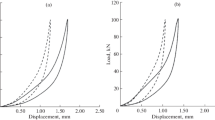Abstract
This report presents the results from an experimental and analytical investigation of the stress distributions occurring in a rail shear test. The effects of nonuniform stresses induced by differential thermal expansion, rail flexibility and specimen aspect ratio on measured shear modulus and ultimate strength of composite laminates are shown. A two-dimensional linearly elastic finite-element model was used to analytically determine how various geometric parameters influenced the magnitude and distribution of inplane normal and shear stresses in a tensile-rail-shear specimen. Rail shear tests were conducted at room temperature and 589 K (600°F) on selected graphite-polyimide composite laminates using two titanium rail configurations. The analysis and test methods are discussed, and the results of the effects of the various parameters on shear modulus and ultimate strength are presented.
Similar content being viewed by others

Abbreviations
- a :
-
width of specimen test section
- b :
-
length of specimen test section
- C 0 , C 1 , C 2 , C 3 :
-
coefficients of polynomial equation; see Appendix
- E :
-
modulus of elasticity for an isotropic material
- E 1 :
-
modulus of elasticity for a lamina in the fiber direction
- E 2 :
-
modulus of elasticity for a lamina in the direction transverse to the fibers
- G :
-
shear modulus of an isotropic material
- G 12 :
-
shear modulus of a lamina
- G xy :
-
shear modulus of a laminate
- n :
-
total number of test points; see Appendix
- P :
-
load applied to rail
- S τ/γ :
-
standard error of estimate; see Appendix
- t :
-
test specimen thickness
- x :
-
coordinate axis across specimen width, see Fig. 2
- y :
-
coordinate axis along specimen length, see Fig. 2
- α:
-
thermal coefficient of expansion for an isotropic material
- α1 :
-
thermal coefficient of expansion for a lamina in the fiber direction
- α2 :
-
thermal coefficient of expansion for a lamina in the direction transverse to the fibers
- α12 :
-
shear strain in the 1–2 plane of the lamina
- α xy :
-
shear strain in the x-y plane of a laminate
- \( \in _x \) :
-
normal strain in the x-direction
- \( \in _y \) :
-
normal strain in the y-direction
- θ:
-
ply orientation angle measured from y-axis, see Fig. 2
- ν:
-
Poisson's ratio for an isotropic material
- \(v_{12} \) :
-
Poisson's ratio for a lamina
- σ x :
-
normal stress in x-direction
- σ y :
-
normal stress in y-direction
- σ ult :
-
ultimate normal stress
- \(\tau _{12} \) :
-
shear stress in the 1–2 plane of the lamina
- \(\tau _{xy} \) :
-
shear stress in the x-y plane of a laminate
- \(\tau _{ult} \) :
-
ultimate shear stress
- \(\bar \tau \) :
-
nominal shear stress computed as\(\bar \tau = P/bt\)
- i:
-
index counter, see Appendix
- 1:
-
lamina coordinate axis along fiber
- 2:
-
lamina coordinate axis transverse to fiber
- C:
-
compression
- T:
-
tension
References
Coker, E.G., “An Optical Determination of the Variation of Stress in a Thin Rectangular Plate Subjected to Shear,”Proc. of the Royal Soc. of London (Series A),86,291 (1912).
Whitney, J.M., Stansbarger, D.L. andHowell, H.B., “Analysis of the Rail Shear Test — Applications and Limitations,”J. of Comp. Matls,5,24 (Jan.1971).
Whitney, J.M., “Free Edge Effects in the Measurement of Composite In-Plane Shear Properties,”Air Force Materials Laboratory, Wright-Patterson Air Force Base, OH, Tech. Rept. No. AFML-TR 70-28 (Feb.1971).
Whitney, J.M., “Testing and Characterization of Composite Materials,”Air Force Matls. Lab., Wright-Patterson Air Force Base, OH, Tech. Rept No. AFML-TR-71-124 (June1971).
Bergner, H.W. Jr., Davis, J.G. Jr. and Herakovich, C.T., “Analysis of Shear Test Methods for Composite Laminates,” NASA Contractor Rept. No. 152704 (1977).
Whetstone, W.D., SPAR Structural Analysis Systems Reference Manual, Engineering Information Systems, Inc., San Jose, CA, NASA Contractor Rept. No. NASA-CR-145098-1.
Metal Progress Databook 1976, ASM, Metals Park, OH (1976).
Hanson, M.P. and Chamis, C.G., “Experimental and Theoretical Investigation of HT-S/PMR-PI Composites for Application to Advanced Aircraft Engines,” Reinforced Plastics/Composites Institute, The Soc. of Plast. Ind., Inc., 29th Annual Tech. Conf., Section 16-C, 1 (1974).
Weisshaar, T.A. andGarcia, R., “Analysis of Graphite-Polyimide Rail Shear Specimens Subjected to Mechanical and Thermal Loading,”NASA-Langley Research Center, Hampton, VA, Contractor Rept. No. CR-3106 (March1979).
Author information
Authors and Affiliations
Rights and permissions
About this article
Cite this article
Garcia, R., Weisshaar, T.A. & McWithey, R.R. An experimental and analytical investigation of the rail shear-test method as applied to composite materials. Experimental Mechanics 20, 273–279 (1980). https://doi.org/10.1007/BF02328411
Received:
Revised:
Issue Date:
DOI: https://doi.org/10.1007/BF02328411


